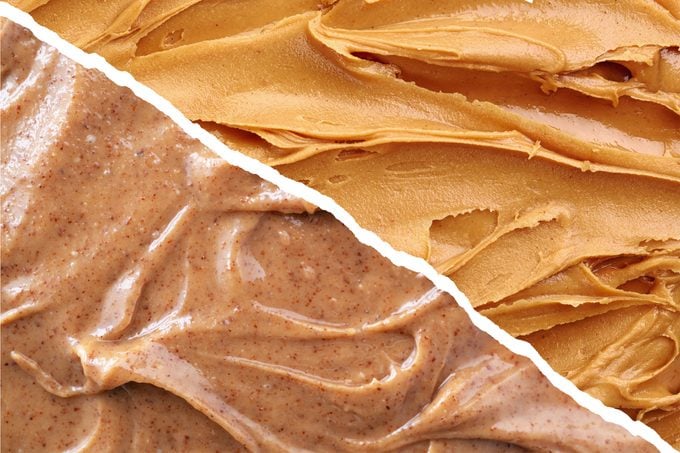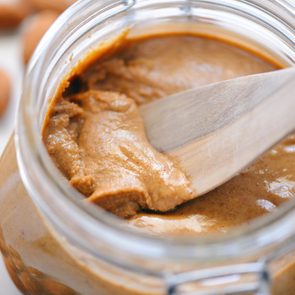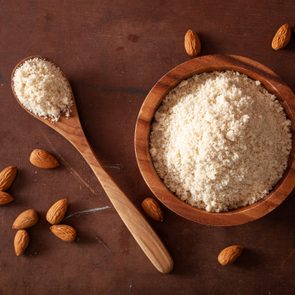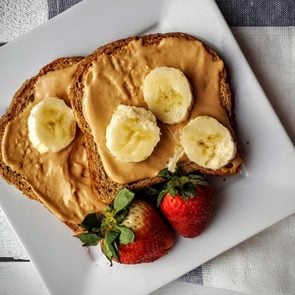Almond Butter vs. Peanut Butter: Which is Healthier?
Updated: Mar. 18, 2021
These nut butters have a similar nutrition profile. Here's what you need to know about the differences between almond butter and peanut butter.
Almond butter versus peanut butter
Peanut butter has more competition than ever, as a growing number of nut and seed butters now join it on supermarket shelves, in between slices of bread, and anywhere else peanut butter traditionally appears.
Almond butter is a popular and easy-to-find peanut butter alternative, but is it really any better for you than plain old peanut butter?
Not necessarily, says Kristi Crowe-White, RD, associate professor and department chair, department of human nutrition and hospitality management, University of Alabama. “The nutrient profiles aren’t that different between almond butter and peanut butter,” she says.
Almond butter contains roasted almonds, while peanut butter contains roasted peanuts, which are technically legumes (not tree nuts like almonds or walnuts). Other ingredients may be added for taste, texture, or to preserve shelf life.
Here’s what you need to know about the nutrition profiles of the two butters and how to choose the best one for your health needs.

Calories and healthy fats
The two nut butters, in their natural forms without added ingredients, are essentially equal when it comes to calories, protein, carbs, fiber, and fat, explains Eshani Ewing, RD at Orlando Health in Orlando.
The two nut butters contain a mix of healthy monounsaturated fats and polyunsaturated fats along with less-healthy saturated fat. Compared to peanut butter, almond butter has slightly more heart-healthy monounsaturated fat than peanut butter, Ewing says.
Monounsaturated fats help reduce blood levels of low-density lipoprotein or “bad cholesterol” and lower your risk of heart disease and stroke.
Here are the nutrition facts for one tablespoon of peanut butter and one tablespoon of almond butter. Note that fiber is higher for almond butter and sugar content is higher for peanut butter, but protein and calories are nearly identical.
Peanut butter nutrition facts
Calories: 96 calories
Protein: 3.6 g (8% DV)
Carbs: 4 g
Fiber: 0.8 g (4% DV)
Fat: 8 g (13% DV)
Sugar: 1.7 g
Almond butter nutrition facts
Calories: 98 calories
Protein: 3.4 g (7% DV)
Carbs: 3 g
Fiber: 1.6 g (7% DV))
Fat: 9 g (14% DV)
Sugar: 1 g
Vitamin and mineral profiles
Almond butter does have slightly more of the powerful antioxidant vitamin E, iron, magnesium, and calcium than its peanut counterpart. The almond’s high vitamin E content is considered one of this tree nut’s biggest and best health benefits. (Here are other health benefits of almonds.)
“Almond butter has about eight times more calcium than peanut butter,” Ewing says. This works out to be 56 mg versus the peanut’s 7 mg per tablespoon. Getting enough calcium is important for healthy bones. The National Institutes of Health recommends 1,000 milligrams a day of calcium if you’re between 19 and 50 and 1,200 mg if you’re a woman over 50 or man over 70.
Taken together, these nutritional differences are too small to tip the scale in favor of almond butter over peanut butter for everyone.
“If you don’t get enough of these vitamins or minerals in your diet, it may make sense to add some almond butter from time to time,” Ewing says.
Added ingredients
Almond butter is usually lower in sugar than peanut butter, but it’s important to read the labels and choose brands with no added sugar, Crowe-White says.
Look for brands with a single ingredient such as roasted almonds or roasted peanuts, she suggests. “You want to see nothing but your nut of choice,” she says. Also look out for added salt, oil, preservatives, or chocolate, she notes. These can be added to improve taste or texture, or to extend shelf life.
So, when it comes to almond butter versus peanut butter, “The decision depends on what else is added to the butters,” says Crowe-White.
Other health concerns
Peanuts tend to contain traces of poisonous substances called aflatoxin from Aspergillus fungi, says Robin Foroutan, RD, integrative medicine dietitian at Morrison Center in New York City and spokesperson for the Academy of Nutrition and Dietetics.
Aflatoxin is a known cancer-causing chemical. “Roasting reduces the amount of aflatoxin, but doesn’t totally eliminate it,” she says. “There’s a max allowable limit of aflatoxin in peanuts and other foods, which is established by the FDA, so we don’t have the same instances of full-blown aflatoxin outbreaks as they have in parts of the world that grow peanuts.”
Still, she says, there is concern about whether that threshold is too high. “The European Union’s allowable levels are a fraction of what the U.S. allows.”
That doesn’t mean you should never eat peanuts or peanut butters, she cautions.
Her advice to clients? “Rotate the kinds of nuts and nut butters you choose,” she says. “Each kind of nut and seed has its own flavor, texture, and mix of nutrients, so just like most things, variety is a good thing.”
Almond butter is more expensive than peanut butter largely due to the harvesting and processing involved, Ewing adds. (Want to try almonds in another form? Check out almond milk benefits.)
The last word
Almond and peanut butter have similar nutrition profiles, so there’s a place for both in a healthy diet, as long as you choose natural varieties without added salt or sugar.
Given the differences in cost, Ewing suggests that you consider using peanut butter in recipes that call for larger amounts and use almond butter on your toast or in a smoothie. If you are allergic to tree nuts like almonds, peanut butter is the clear winner. (Although be sure to consult an allergist, as you can be allergic to both.)
Next, here are the healthiest nuts you can eat.
























